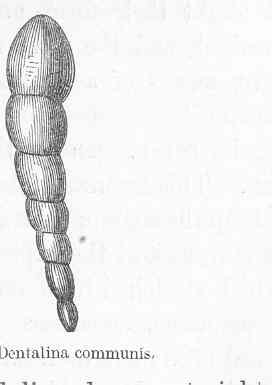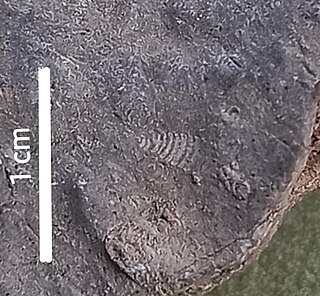
The Fusulinida is an extinct order within the Foraminifera in which the tests are traditionally considered to have been composed of microgranular calcite. Like all forams, they were single-celled organisms. In advanced forms the test wall was differentiated into two or more layers. Loeblich and Tappan, 1988, gives a range from the Lower Silurian to the Upper Permian, with the fusulinid foraminifera going extinct with the Permian–Triassic extinction event. While the latter is true, a more supported projected timespan is from the Mid-Carboniferous period.
Abadehella is a genus of large Upper Permian benthic forams in the order Fusulinida. It is the sole known genus of the family Abadahellidae, for which the diagnosis is the same. Abadahellidae was established by Loeblich and Tappan 1984; Abadahella by Okimura and Ishi, 1975.
The Moravamminacea is a superfamily of foraminifera within Fusulinida that comprises genera in which the proloculus is followed by a coiled or straight second chamber, and in which periods of growth result in partial or incipient septa. Contains three families, Caligellidae, Moravamminidae, and Paratickenellidae, with an overall range from the upper Silurian to the Lower Carboniferous (Mississippian).
The Nodosinellacea is a superfamily of fusulinids in which the test is of one or more distinct chambers with the wall single layered or with a microgranular outer layer and fibrous inner layer. Differs from the Geinitzinacea in that the latter has the layers reversed.
The Fusulinacea is a superfamily in the Fusulinida in which the test is spherical, discoida, or fusiform; commonly coiled, less often uncoiling in the late stage, numerous chambers per whorl; test wall of microgranular calcite in one to four layers. Tunnels or secondary foramina may result from partial resorption and secondary deposition may produce chomata, parachomate, tectoria, and axial fillings. Range: M Devonian (Givetian) – U Permian
The Fusulinidae is a family of fusulinacean foraminifera from the upper Carboniferous to the Upper Permian (Guadalupian), tests of which are fusiform to subcylindrical with walls of two to four layers. Are planispirally coiled throughout or with early whorls at a distinct angle to the later plane of coiling. Septa, flat to well fluted; tunnel, single; chomata variable in development.
Verbeekinidae are a family of large fusulinaceans characterized by subspherical, planispirally coiled tests and a long coiling axis. The wall is composed of a dense outer tectum and inner alveolar keriotheca. They are most prominent in Japan and Southeast Asia.

Lagenida is an order of benthic foraminiferal protists in which the tests (shells) are monolamellar, with walls composed of optically and ultra-structurally radiate calcite, with the crystallographic c-axes perpendicular to the surface. Lagenids first appear in the Upper Silurian and continue to the Recent. They are currently divided into two superfamilies, the older Robuloidacea which range from the Upper Silurian to the Lower Cretaceous (Albian) and the younger Nodosariacea, ranging from the Permian to Recent.
Nodosariacea is one of two superfamilies making up the foraminiferal order Lagenida. The other being the Robuloidacea. Of these two Nodosariacea is the more advanced, as well as being the younger.
Involutinida is an order of foraminifera included in the Spirillinata found in the fossil record from the early Permian to early Late Cretaceous (Cenomanian).
Miliamellus is a genus of Cenozoic benthic foraminifera with tests made of imperforate opaline silica. It is the only genus in the order Silicoloculinida and the family Silicoloculinidae. It is sometimes referred to by the junior synonym Silicoloculina.

Cibicides is a genus of cosmopolitan benthic foraminifera known from at least as far back as the Paleocene that extends down to the present.
Rosalina is a genus of foraminifera included in the rotaliid family Rosalinidae.
Favocassidulina is a foraminiferal genus; rotaliid family Cassidulinidae, known from the middle Miocene to recent in the Indian and Pacific oceans. Its habitat is benthic, near shore.
Schwagerina is an extinct genus of fusulinacean Foraminifera that is used as an Early Permian index fossil. The overall shape of the shell or test is fusiform to subcylindrical, the spirotheca, or outer test wall, is thick, and composed of tectum and alveolar keriotheca; the septa are fluted throughout the length of the shell, intense to top of chambers in some, only in lower parts in others; axial fillings highly variable, chomata distinct or thin and discontinuous.

Geinitzina is a genus of Foraminifera from the early Carboniferous (late Mississippian to the late Permian that may have extended into the Triassic. Chambers are uniserial, arranged in a single row, or line. Test wall is double layered. The outer layer is of hyaline radial calcite, and is light in color. The inner layer is of microgranular calcite, and is dark is color. Both layers are secreted by the protoplasm.

Geinitzinidae is an extinct family of Foraminifera from the late Paleozoic included in the Fusulinida that comprises genera characterized by unserial tests (chambers arranged in a single row, or line, in which walls are double layered. The outer layer is of light colored hyaline radial calcite. The inner layer is a dark, secreted, microgranular calcite.
Alfred R. Loeblich Jr (1914–1994) was an American micropaleontologist. He was married to Helen Niña Tappan Loeblich and the two co-authored a number of important works on the Foraminifera and related organisms.
The Ventrolaminidae are a family of benthic Foraminifera included in the Involutinida, now part of the subclass Spirillinana, class Spirillinata.

Anchispirocyclina is a genus of agglutinated discoidal forams known from the upper Jurassic to the lower Cretaceous of Europe, north Africa, USA and Cuba.





